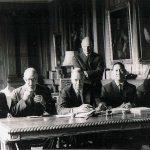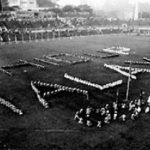1961
 On 27 May 1961, Abdul Rahman proposed the idea of forming "Malaysia", which would consist of Brunei, Malaya, North Borneo, Sarawak, and Singapore, all except Malaya still under British rule. It was stated that this would allow the central government to better control and combat communist activities, especially in Singapore. It was also feared that if Singapore became independent, it would become a base for Chinese chauvinists to threaten Malayan sovereignty.
On 27 May 1961, Abdul Rahman proposed the idea of forming "Malaysia", which would consist of Brunei, Malaya, North Borneo, Sarawak, and Singapore, all except Malaya still under British rule. It was stated that this would allow the central government to better control and combat communist activities, especially in Singapore. It was also feared that if Singapore became independent, it would become a base for Chinese chauvinists to threaten Malayan sovereignty.
The proposed inclusion of British territories besides Singapore was intended to keep the ethnic composition of the new nation similar to that of Malaya, with the Malay and indigenous populations of the other territories cancelling out the Chinese majority in Singapore. At the Commonwealth Prime Ministers Conference in 1961, Abdul Rahman explained his proposal further to its opponents. In October, he obtained agreement from the British government to the plan, provided that feedback be obtained from the communities involved in the merger. Members of the Cobbold Commission were formed to conduct a study in the British Borneo territories of Sarawak and Sabah to see whether the two were interested in the idea to form the Federation of Malaysia with Malaya and Singapore.
The Cobbold Commission, named after its head, Lord Cobbold, conducted a study in the Borneo territories and approved a merger with North Borneo and Sarawak; however, it was found that a substantial number of Bruneians opposed merger. North Borneo drew up a list of points, referred to as the 20-point agreement, proposing terms for its inclusion in the new federation. Sarawak prepared a similar memorandum, known as the 18-point agreement. Some of the points in these agreements were incorporated into the eventual constitution, some were instead accepted orally. These memoranda are often cited by those who believe that Sarawak's and North Borneo's rights have been eroded over time. A referendum was conducted in Singapore to gauge opinion, and 70% supported merger with substantial autonomy given to the state government. The Sultanate of Brunei withdrew from the planned merger due to opposition from certain segments of its population as well as arguments over the payment of oil royalties and the status of the sultan in the planned merger.
After reviewing the Cobbold Commission's findings, the British government appointed the Landsdowne Commission to draft a constitution for Malaysia. The eventual constitution was essentially the same as the 1957 constitution, albeit with some rewording; for instance, giving recognition to the special position of the natives of the Borneo States. North Borneo, Sarawak and Singapore were also granted some autonomy unavailable to the states of Malaya.
Indonesia- Malaysia Confrentation
1963
 After reviewing the Cobbold Commission's findings, the British government appointed the Landsdowne Commission to draft a constitution for Malaysia. The eventual constitution was essentially the same as the 1957 constitution, albeit with some rewording; for instance, giving recognition to the special position of the natives of the Borneo States. North Borneo, Sarawak and Singapore were also granted some autonomy unavailable to the states of Malaya. After negotiations in July 1963, it was agreed that Malaysia would come into being on 31 August 1963, consisting of Malaya, North Borneo, Sarawak and Singapore. The date was to coincide with the independence day of Malaya and the British giving self-rule to Sarawak and North Borneo. However, Indonesia and the Philippines strenuously objected to this development, with Indonesia claiming Malaysia represented a form of "neocolonialism" and the Philippines claiming North Borneo as its territory. The opposition from the Indonesian government led by Sukarno and attempts by the Sarawak United People's Party delayed the formation of Malaysia. Due to these factors, an eight-member UN team was formed to re-ascertain whether North Borneo and Sarawak truly wanted to join Malaysia.
After reviewing the Cobbold Commission's findings, the British government appointed the Landsdowne Commission to draft a constitution for Malaysia. The eventual constitution was essentially the same as the 1957 constitution, albeit with some rewording; for instance, giving recognition to the special position of the natives of the Borneo States. North Borneo, Sarawak and Singapore were also granted some autonomy unavailable to the states of Malaya. After negotiations in July 1963, it was agreed that Malaysia would come into being on 31 August 1963, consisting of Malaya, North Borneo, Sarawak and Singapore. The date was to coincide with the independence day of Malaya and the British giving self-rule to Sarawak and North Borneo. However, Indonesia and the Philippines strenuously objected to this development, with Indonesia claiming Malaysia represented a form of "neocolonialism" and the Philippines claiming North Borneo as its territory. The opposition from the Indonesian government led by Sukarno and attempts by the Sarawak United People's Party delayed the formation of Malaysia. Due to these factors, an eight-member UN team was formed to re-ascertain whether North Borneo and Sarawak truly wanted to join Malaysia.
Malaysia formally came into being on 16 September 1963, consisting of Malaya, North Borneo, Sarawak, and Singapore. In 1963 the total population of Malaysia was about 10 million.
On 9 August 1965, Singapore separated from Malaysia to become an independent and sovereign state.The separation was the result of deep political and economic differences between the ruling parties of Singapore and Malaysia, which created communal tensions that resulted in racial riots in July and September 1964. At a press conference announcing the separation, then Singapore Prime Minister Lee Kuan Yew was overcome by emotions and broke down. Singapore’s union with Malaysia had lasted for less than 23 months.
Exhibition Menu
Menu Merdeka
- Pameran Merdeka – Hari Kemerdekaan Malaysia
- Merdeka – The Early Days
- Merdeka – Western Colonization
- Merdeka – Japanese Invasion & The Emergency
- Perjuangan Kemerdekaan
- 31 Ogos 1957
- Kelahiran Malaysia
- Pelajaran Erti Perpaduan
- Negara Sejahtera
- Malaysia Baharu
- Normal Baharu
- Merdeka – Tema dan Logo Sambutan
 Bendera Malaysia, juga dikenali sebagai Jalur Gemilang in Malay ("Stripes of Glory"), is composed of a field of 14 jalur merah dan putih berselang-seli along the fly and a blue canton bearing a crescent and a 14-point star known as the Bintang Persekutuan (Federal Star). The 14 stripes, of equal width, represent the equal status in the federation of the 13 member states and the federal territories, while the 14 points of the star represent the unity between these entities. The crescent represents Islam, the country's state religion; the blue canton symbolizes the unity of the Malaysian people; the yellow of the star and crescent is the royal color of the Malay rulers
Bendera Malaysia, juga dikenali sebagai Jalur Gemilang in Malay ("Stripes of Glory"), is composed of a field of 14 jalur merah dan putih berselang-seli along the fly and a blue canton bearing a crescent and a 14-point star known as the Bintang Persekutuan (Federal Star). The 14 stripes, of equal width, represent the equal status in the federation of the 13 member states and the federal territories, while the 14 points of the star represent the unity between these entities. The crescent represents Islam, the country's state religion; the blue canton symbolizes the unity of the Malaysian people; the yellow of the star and crescent is the royal color of the Malay rulers
[aiovg_video id=7351]
Negaraku (My Country) is the national anthem of Malaysia. It was selected as a national anthem at the time of the Federation of Malaya's independence from the UK in 1957. The tune was originally used as the regional anthem of Perak, which was adopted from a popular French melody titled "La Rosalie" composed by the lyricist Pierre-Jean de Béranger. Source
Negaraku,
Tanah tumpahnya darahku
Rakyat hidup
Bersatu dan maju
Rahmat Bahagia
Tuhan kurniakan
Raja kita
Selamat bertakhta
Rahmat Bahagia
Tuhan kurniakan
Raja kita
Selamat bertakhta
My motherland
The land where my blood has spilt
Where the people live
United and progressive
With God given
Blessings of happiness
May our King
Reign in peace
With God given
Blessings of happiness
May our King
Reign in peace
Negara kita, MALAYSIA memupuk cita-cita:
- Mencapai perpaduan yang lebih sempurna di kalangan seluruh masyarakatnya
- Memelihara cara hidup demokrasi
- Mewujudkan masyarakat yang adil di mana kemakmuran negara dapat dinikmati bersama secara adil dan saksama
- Menjamin pendekatan terbuka terhadap tradisi budayanya yang kaya dan pelbagai; dan
- Membina masyarakat progresif yang akan menggunakan sains dan teknologi moden.
Kami, Orang Malaysia, mengikrarkan usaha bersatu kami untuk mencapai matlamat ini berpandukan prinsip-prinsip ini:
KEPERCAYAAN KEPADA TUHAN
KESETIAAN KEPADA RAJA DAN NEGARA
KELUHURAN PERLEMBAGAAN
KEDAULATAN UNDANG-UNDANG
KESOPANAN DAN KESUSILAAN
Tema Hari Merdeka
Malaysia Prihatin
Logo

 Malaysia is a country in Southeast Asia. The federal constitutional monarchy consists of 13 states and three federal territories, separated by the South China Sea into two similarly sized regions, Peninsular Malaysia and East Malaysia (Malaysian Borneo). Peninsular Malaysia shares a land and maritime border with Thailand and maritime borders with Singapore, Vietnam, and Indonesia. East Malaysia shares land and maritime borders with Brunei and Indonesia and a maritime border with the Philippines and Vietnam. Kuala Lumpur is the national capital and largest city while Putrajaya is the seat of federal government. With a population of over 30 million, Malaysia is the world's 44th most populous country. The southernmost point of continental Eurasia, Tanjung Piai, is in Malaysia. In the tropics, Malaysia is one of 17 mega diverse countries, with large numbers of endemic species. Source
Malaysia is a country in Southeast Asia. The federal constitutional monarchy consists of 13 states and three federal territories, separated by the South China Sea into two similarly sized regions, Peninsular Malaysia and East Malaysia (Malaysian Borneo). Peninsular Malaysia shares a land and maritime border with Thailand and maritime borders with Singapore, Vietnam, and Indonesia. East Malaysia shares land and maritime borders with Brunei and Indonesia and a maritime border with the Philippines and Vietnam. Kuala Lumpur is the national capital and largest city while Putrajaya is the seat of federal government. With a population of over 30 million, Malaysia is the world's 44th most populous country. The southernmost point of continental Eurasia, Tanjung Piai, is in Malaysia. In the tropics, Malaysia is one of 17 mega diverse countries, with large numbers of endemic species. Source
The country is home to people of various national, ethnic and religious origins. Majority of the population, however, belong to several clearly defined ethnolinguistic groups within the country with their own distinct cultures and traditions: Malays, Orang Asli (aboriginal population), Malaysian Chinese (primarily Han Chinese), Malaysian Indians (primarily Tamils). Malays themselves are the source of the name Malaysia ("land of Malays") as they traditionally formed the majority during the British rule. The majority of the non-Malay and non-aboriginal population in modern Malaysia is made up of immigrants and their descendants. Following the initial period of Portuguese, Dutch and then significantly longer British colonization, different waves (or peaks) of immigration and settlement of non-aboriginal peoples took place over the course of nearly five centuries and continue today. Source
Tema
Logo dan tema yang tidak dapat dilupakan yang telah dicipta sempena sambutan Merdeka sejak 1976. Lagi
Acara Hari Merdeka
Don't miss out the Merdeka celebration at your local area, state or the big parade at National Merdeka level. Check the events date and hours! Lagi
Galeri Sambutan
Layari galeri imej berwarna-warni terpilih bersempena dengan sambutan Merdeka di seluruh negara. Lagi
Pameran Dalam Talian
 The Merdeka exhibition was produced by User Experience Service Unit, PSB UUM as part of Online Exhibition series.
The Merdeka exhibition was produced by User Experience Service Unit, PSB UUM as part of Online Exhibition series.
